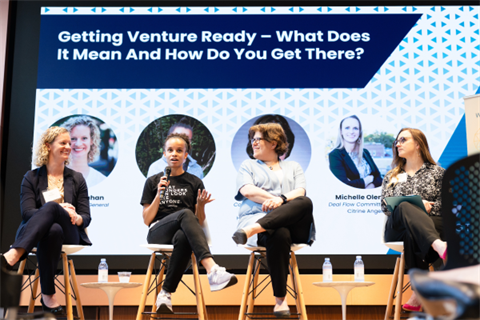Getting Venture Ready
June 10, 2024

Last month, Arlington Economic Development (AED) held a panel discussion at the National Landing Experience Center, focused on getting venture ready. Powered by Citrine Angels, this was the second installment of the “Elevate Your Venture: Arlington Female Founder Series,” which kicked off this past spring with a packed house to discuss if venture capital is right for you. Learn more about that here.
Citrine Angels Executive Board member and Dealflow Chair Michelle Olenoski moderated the conversation with Dahna Goldstein, co-founder and managing partner of Halcyon Venture Partners; Emily McMahan, co-founder and general partner of AIN Ventures; and Haley Bryant, principal of Hustle Fund.
The panel picked up where the last session ended. Assuming the entrepreneur determined that venture capital was the preferred path for them and they consider their company to be a venture-backable startup, the focus turned to helping them prepare to raise capital from an angel investor or a venture capital fund. The discussion focused on how to find and evaluate investors, tips for determining fundraising terms and how to craft a successful pitch.
How and When to Find and Evaluate Investors
When entrepreneurs decide to raise funds, they are giving up some ownership of their company. Founders need to consider giving up an appropriate percentage of ownership for the type of capital being raised, be it pre-seed, seed or beyond.
Professional venture investors differ from angel investors because their ultimate job is to make the most money for the people who have invested in their funds. Angel investors want to make money, but they are called angels because they often come in before venture investors—and are often willing to take more risks, can wait longer to have their capital returned and/or are motivated by the idea more than the traction.
At the seed round, venture investors are looking for an inflection point where the company will start commercializing its product. They want to see that the company is close to finding product market fit and getting ready to scale revenue. The company needs to be poised to scale. Goldstein noted that she likes to see that R&D-heavy companies have received non-diluted financing, such as an SBIR or an NIH grant.
Bryant explained that building a capitalization table (bringing on investors) is like hiring. It’s easy for entrepreneurs to get into a security mindset of “take the money and run,” but the reality is that founders are starting what hopefully will become a long-term relationship with an investor who can provide capital, knowledge and connections.
In terms of where to find investors, the key takeaway is to leverage networks. “In D.C., your network is your currency,” Goldstein emphasized. McMahan discussed the importance of going to startup events, coffee meetings and pitch competitions.
Tips for Determining Fundraising Round and Terms
Traction is a key part of fundraising. Revenue is a key measure of traction, but there are other ways to achieve it. Examples include having large waitlists of customers willing to buy and conducting extensive customer discovery to show demand.
The panelists encouraged founders to construct a round that’s right for the company’s current size. Each round of financing is de-risking a different piece of the company. If a company is pre-revenue and looking to raise an amount that’s too large, it could hurt the founder’s ownership and negatively impact subsequent rounds. Focus on what is needed to get to the next level without losing too much ownership.
Resources like MBCA, Pitchbook and Carta are great for providing valuation benchmarks. Understanding terms like MFN (most-favored-nation) clauses, information rights and having pro-rata is also incredibly helpful. Ultimately, founders want to ensure they are balancing being fair for the current round while taking into consideration how it may impact future rounds.
Crafting a Successful Pitch
The job of the pitch is to get to a longer conversation. No one will ever write a check immediately after the initial conversation. Pitches fall flat when a founder tries to explain every technical detail of the solution or spends 90% of their time pitching, leaving no room for conversation.
Instead, focus on getting potential investors excited. Discuss the size of the market, how unique the company’s solution is, and why you (the founder) are the right person at this moment.
Understand the investor’s motivations, such as their investment thesis, the size of the checks they write and what they are looking for – then weave that into the conversation.
Founders need to be able to succinctly answer the following questions:
- What problem are you solving?
- Who are you solving it for? Do they currently pay to solve this problem?
- What are the alternatives and why are you better?
- What have you achieved to date in solving this problem?
- How big is the market, and how unique is the solution?
AED and Citrine Angels thank everyone who attended our panel. We hope you found it interesting and informative. Our Elevate Your Venture Speaker Series will resume in the fall with a panel on building the right team.